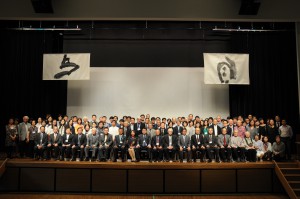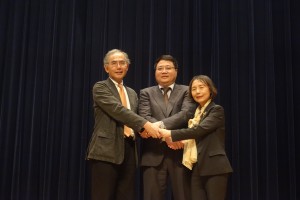Journal of Cultural Interaction in East Asia Vol.7 ―Table of Contents
Preface
| Toward Responsibility for a Cooperative “East Asian Era:” New Developments in Cultural Interaction Studies in East Asia (WANG Min) |
詳細 |
Articles
| Overview of Research on Relics of Yu the Great (ŌWAKI Yoshio) | 詳細 |
| Natural Disasters and the Development of Chinese History (ZHAO Xiaohua) | 詳細 |
| Questions Raised by the Nuclear Power Accident of March 11, 2011 (SHIMAZONO Susumu) | 詳細 |
| Francis Bacon in Yan Fu’s Tianyan lun (SHEN Guowei) | 詳細 |
| European Art Music and Its Role in the Cultural Interaction between Japan and the East Asian Continent in the Nineteenth and Early Twentieth Centuries (Margaret MEHL) | 詳細 |
| Confusion to Conviction: The Representative, Multilingual Religious Journey of Takakura Tokutarō (1885-1934) (J. Nelson JENNINGS) | 詳細 |
| The Founding of Singapore and the Chinese Kongsis of West Borneo (ca.1819–1840) (Ying-kit CHAN) | 詳細 |
Opinion Forum
| Culture as Encounter: A Polemic against the Trend of Ideological Thinking in the Field of Chinese Studies (Wolfgang KUBIN) | 詳細 |
| “Other Visions of Virtue” in Ordinary Economies in Japan: A Historical Perspective, 1750-1950. (Tetsuo NAJITA) | 詳細 |
| China Studies in Germany (LI Xuetao) | 詳細 |
| The Zhongguo Trademark in Modern East Asia (Kirill Ole THOMPSON) | 詳細 |
Book Review
| Review of “Ajia” o Kangaeru 2000-2015 (Thinking about “Asia,” 2000-2015), Fujiwara Shoten editorial staff, ed., June, 2015. (JIANG Keshi) | 詳細 |
| Review of Nihonjin wa Nihon o dō mitekita ka: Edo kara miru jiishiki no hensen (How the Japanese Have Viewed Japan: Changes in Views in the Edo Period), edited by Tanaka Yūko. Tokyo: Kasama Shoin, 2015. (WANG Min) | 詳細 |
| Review of Uō to Nihonjin: Chisuishin ga tsunagu Higashi Ajia (Yu the Great and the Japanese: East Asia Linked by the Sage-King Who Controlled the Flood Waters), by Wang Min. Tokyo: NHK Shuppan, 2014. (LOU Zhenghao) | 詳細 |
Research Trends
| Digital Archive Projects at the Center for the Study of Asian Cultures at Kansai University (HINO Yoshihiro) | 詳細 |
| Resources for Studying Abraham Lincoln and the American Civil War around the World (Daniel W. STOWELL) | 詳細 |
| The University of Tokyo Center for Philosophy (SATŌ Sora) | 詳細 |
International Conferences in East Asia
| Impressions of the Seventeenth World Economic History Congress in Kyoto (MA Min) | 詳細 |
| The 22nd International Congress of Historical Sciences Held in Jinan, China (LIU Jiafeng) | 詳細 |
Contribution Guidelines
| Contribution Guidelines | 詳細 |
Journal for Cultural Interaction in East Asia Vol.7

A commemorative photo of the Seventh Annual Meeting in Kaisei-machi, Kanagawa Prefecture, Japan, on May 9, 2015
A commemorative photo of the change of president on May 10, 2015
From left: Vice-President UCHIDA Keiichi, Ex-President ZHANG Qing, President WANG Min
Preface: Toward Responsibility for a Cooperative “East Asian Era:” New Developments in Cultural Interaction Studies in East Asia
WANG Min
Overview of Research on Relics of Yu the Great
ŌWAKI Yoshio
Natural Disasters and the Development of Chinese History
ZHAO Xiaohua
Questions Raised by the Nuclear Power Accident of March 11, 2011
SHIMAZONO Susumu
Francis Bacon in Yan Fu’s Tianyan lun
SHEN Guowei
Abstract: Previous studies of the sources of thought in Yan Fu’s Tianyan lun have failed to give sufficient attention to Francis Bacon. The source of Yan Fu’s ideal of a strong and prosperous China is, I think, none other than Bacon. This paper discusses Bacon as he appeared in Yan Fu’s Tianyan lun and political essays written at the time of Tianyan lun, and Bacon’s influence on Yan Fu.
Keywords: Science, Bacon, Western studies, Tianyan lun, Yan Fu
 ダウンロード[English](PDF)
ダウンロード[English](PDF)
European Art Music and Its Role in the Cultural Interaction between Japan and the East Asian Continent in the Nineteenth and Early Twentieth Centuries
Margaret MEHL
Abstract: The fact that much of what the Japanese regard as part of their culture originally came to Japan from the Asian continent in ancient and medieval times is well known and has been extensively researched. For the period after 1868, however, the attention of scholars has tended to concentrate on Japan’s comprehensive importation of Western civilization. This exploratory article suggests a ifferent perspective. Taking music in modern Japan as an example and based in part on the author’s research for her recent book Not by Love Alone: The Violin in Japan, 1850‒2010, the author will argue that music is a particularly rewarding fi eld for examining transnational fl ows. Research on music in modern Japan has tended to privilege the introduction of European art music from the West and this was undoubtedly one of the most important developments in the nineteenth and twentieth centuries. There are, however, aspects to this development that merit more attention than they have received so far, including the relationship between Western music and other musics practised in Japan in the nineteenth century and the interactions between Japan and non-Western countries and in particular its East Asian neighbours. In this article, four general themes for further enquiry are introduced: 1. The possible relation between Meiji statesmen’s and intellectuals’ kangaku education and their views on the role of music in the modern state. 2. The Chinese origins and the place of minshingaku (Ming and Qing music) in the musical culture of nineteenthcentury Japan. 3. Japan’s role in the dissemination of Western Music in East Asia. 4. The role of the East Asian continent (particularly the cities of Shanghai and Harbin) as a place of encounter between Asia and Europe.
Keywords: music, East Asia, Japan, Korea, China, transnational flows, globalization
 ダウンロード[English](PDF)
ダウンロード[English](PDF)
Confusion to Conviction: The Representative, Multilingual Religious Journey of Takakura Tokutarō (1885-1934)
J. Nelson JENNINGS
The Founding of Singapore and the Chinese Kongsis of West Borneo (ca.1819–1840)
Ying-kit CHAN
Abstract: Many historians have examined why Singapore failed to be a major trading center before the nineteenth century. This paper revisits the current scholarly literature on the founding of Singapore to make two arguments. First, I argue that we cannot understand the founding of Singapore and its role in the British Second Empire without delineating Singapore’s role as a forest- and marine-goods metropolis in the precolonial Chinese trading networks of Southeast Asia. Second, I try to show how the Chinese kongsis 公司 of West Borneo turned Singapore into a forest- and marine-goods metropolis, formed their own political and social institutions, and collectively functioned as a third autonomous pseudostate power alongside the British and the Dutch. This reconceptualization enables us to see the founding of Singapore as a joint enterprise, and not a solely British achievement.
Keywords: British Empire, Chinese kongsis, forest and marine goods, Singapore, West Borneo
 ダウンロード[English](PDF)
ダウンロード[English](PDF)
Culture as Encounter: A Polemic against the Trend of Ideological Thinking in the Field of Chinese Studies
Wolfgang KUBIN
“Other Visions of Virtue” in Ordinary Economies in Japan: A Historical Perspective, 1750-1950
Tetsuo NAJITA
China Studies in Germany
LI Xuetao
Abstract: China studies in Germany has undergone great changes since the 1960s. Infl uenced by burgeoning area studies in the United States, German scholarship shifted from traditional philological studies focused on translating and interpreting Chinese classics to practical studies of modern Chinese politics, economy, law, etc. Hence, there was also a shift in research methodologies to those of the social sciences. However, this shift, signifi cant as it is, can never replace traditional Sinological studies aimed at Chinese history and classics. This paper uses Chinese history as an example to explore the development of German academic Sinology. It points out that research in traditional Sinology, as well as in modern China studies, no longer focuses on a particular discipline, but rather follows the trend toward interdisciplinary, comprehensive research. Hence we can expect that China studies will become increasingly decentralized and interactive in the future development of the field.
Keywords: German Sinology, German China studies, Chinese history in Germany
 ダウンロード[English](PDF)
ダウンロード[English](PDF)
The Zhongguo Trademark in Modern East Asia
Kirill Ole THOMPSON
Book Review
JIANG Keshi
Review of “Ajia” o Kangaeru 2000-2015 (Thinking about “Asia,” 2000-2015), Fujiwara Shoten editorial staff, ed., June, 2015.
 ダウンロード[English](PDF)
ダウンロード[English](PDF)
WANG Min
Review of Nihonjin wa Nihon o dō mitekita ka: Edo kara miru jiishiki no hensen (How the Japanese Have Viewed Japan: Changes in Views in the Edo Period), edited by Tanaka Yūko. Tokyo: Kasama Shoin, 2015.
 ダウンロード[English](PDF)
ダウンロード[English](PDF)
LOU Zhenghao
Review of Uō to Nihonjin: Chisuishin ga tsunagu Higashi Ajia (Yu the Great and the Japanese: East Asia Linked by the Sage-King Who Controlled the Flood Waters), by Wang Min. Tokyo: NHK Shuppan, 2014.5.
 ダウンロード[English](PDF)
ダウンロード[English](PDF)
Research Trends
HINO Yoshihiro
Digital Archive Projects at the Center for the Study of Asian Cultures at Kansai University
 ダウンロード[English](PDF)
ダウンロード[English](PDF)
Daniel W. STOWELL
Resources for Studying Abraham Lincoln and the American Civil War around the World
 ダウンロード[English](PDF)
ダウンロード[English](PDF)
SATŌ Sora
The University of Tokyo Center for Philosophy
 ダウンロード[English](PDF)
ダウンロード[English](PDF)
International Conferences in East Asia
MA Min
Impressions of the Seventeenth World Economic History Congress in Kyoto
 ダウンロード[English](PDF)
ダウンロード[English](PDF)
LIU Jiafeng
The 22nd International Congress of Historical Sciences Held in Jinan, China
 ダウンロード[English](PDF)
ダウンロード[English](PDF)


 English
English 日本語
日本語